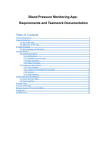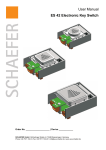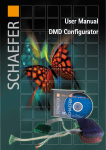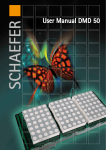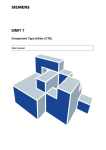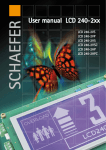Download Rainbow Button User Manual - WS
Transcript
User Manual Rainbow Button RB 42 RD 42 RB 42 2M XI Kapitelbezeichnung Kapitelbezeichnung X.X Unterpunkt SCHAEFER GmbH Winterlinger Str. 4 72488 Sigmaringen Germany Phone +49 7571 722-0 Fax +49 7571 722-99 [email protected] www.ws-schaefer.de Support If you have any questions regarding this product please contact: Phone +49 7571 722-51 Fax +49 7571 722-99 Copyright Duplication (copy, print, microfilm or any other form) as well as electronic spreading of this document is only permitted after formal written consent of SCHAEFER GmbH. SCHAEFER GmbH reserves the right to carry out alterations of technical details without prior notice. For all transactions our General Conditions of Sale and Delivery shall be applicable. All rights reserved. Ress.: 013702 Revision: 2010-10-08 2 Index User Manual RB 42 Index 1 1.1 1.2 1.3 General description .................................. 4 RB 42 .....................................................................4 RD 42 .....................................................................4 RB 42 2M XI ........................................................4 2 Illustration ................................................ 4 3 Configuration ........................................... 5 4 4.1 4.2 4.3 4.4 4.5 4.5.1 4.5.2 4.5.3 Installation and connection ................... 5 Change-over between 3-wire and 4-wire-technology .....................5 RB 42 and RD 42.................................................6 RB 42 2M XI..........................................................7 Connection Power Saver PS 42 and connection of several buttons ......................8 Connection Config Kit .....................................9 Individual button with supply voltage .......9 Individual button without supply voltage .9 Several buttons ............................................... 10 5 5.1 5.2 5.2.1 5.2.2 5.2.3 5.2.4 5.2.5 5.2.6 5.3 5.3.1 Settings ................................................... 11 Button function on/off .................................11 Setting colour and brightness .................... 12 Brightness ”red” in off state ....................... 13 Brightness “green” in off state ................... 13 Brightness ”blue” in off state ..................... 13 Brightness “red” in on state ........................ 13 Brightness “green” in on state ................... 13 Brightness “blue” in on state ...................... 13 Reduction .......................................................... 14 Reduction motion detector ......................... 14 5.3.2 5.3.3 5.4 5.5 5.6 5.7 5.8 5.9 5.10 Reduction light sensor in off state ........... 14 Reduction light sensor in on state ............ 14 Colour change at activation ....................... 15 Colour change at reduction ........................ 15 Max. turn-on time ......................................... 16 Sensitivity ......................................................... 16 Locking several buttons ................................ 17 Sending the configuration .......................... 17 Test mode .......................................................... 17 6 RB 42 2M XI – additional function ....18 7 7.1 7.2 7.3 Characteristics ........................................20 RB 42.................................................................... 20 RD 42................................................................... 21 RB 42 2M XI....................................................... 22 3 General description | Illustration 1.1 RB 42 | 1.2 RD 42 | 1.3 RB 42 2M XI 1 General description 1.1 RB 42 The Rainbow Button RB 42 is a non-contact button for installation behind glass, Perspex®, etc. It reacts to capacitive changes. Doing so, it independently adapts to changed ambient conditions. The colours for quiescent and acknowledgement state can be freely set. Furthermore, the sensitivity and a number of other parameters can be set. All settings can be carried out comfortably with the PC programme Rainbow-Configurator or with the DIP switches directly on the device. The design of the visible touch surface is generally specified by the pressure on the glass surface, and the corresponding area is lit up by the button from the back. In combination with the Power Saver PS 42, further functions are available. Thus, it is possible to reduce the brightness level of the RB 42 dependent on other parameters. 2 Illustration 4 1.2 RD 42 The Rainbow Display RD 42 is identical in construction with the RB 42. The button function is off, however. Thus, the RD 42 serves as luminous display whose colour can be changed via the recall light input. The colours for the deactivated and the acknowledged state are freely adjustable. There is also a reduction function available in combination with the PS 42. 1.3 RB 42 2M XI The RB 42 2M XI has been designed especially for the function as an emergency call button. It has an additional potential-free alternating contact and a monitoring circuit. The monitoring circuit automatically checks the function of the button at an interval of 24 hours. This ensures increased function safety of the button. For information regarding the precise function see section 4.3. Configuration | Installation and connection 4.1 Change-over between 3-wire abd 4-wire technology 3 Configuration There are two configuration options: • The RB 42 is configured by SCHAEFER according to customer specifications. •You configure the RB 42 yourself. You make all settings without additional aids at the RB 42 and afterwards send these settings to a number of other buttons. Alternatively, you can also carry out the settings via the PC programme called „Rainbow-Configurator“. For this, you will need a Windows PC, the Config Kit of SCHAEFER GmbH and the RB 42-ConfigAdapter. 4 Installation and connection The button is meant for installation behind a closed glass surface. From the rear, a stainless steel plate having a rectangular cutout for the RB 42 is bonded. The button is fixed to the stainless steel plate by means of welding studs. The functional earth of the button (green cable) must be connected with the stainless steel plate by means of a welding stud. Upon installation it must be observed that the touch plates are flush and that there is no air space between the glass plate and the touchplates. 4.1 Change-over between 3-wire and 4-wire technology You can switch between 3-wire and 4-wire technology with a jumper. jumper open 4-wire technology jumper inserted 3-wire technology (NO and L1 are internally connected) 5 Connection 4.2 RB 42 and RD 42 4.2 RB 42 and RD 42 jumper for change-over between 3-wire and 4-wire technology jumper for DIP switch for configuration key + key - functional earth (connect to faceplate) 6 L1 L2 NO C + recall light input button output GN D D + supply voltage Connection 4.3 RB 42 2M XI 4.3 RB 42 2M XI plug-in connector for further Rainbow button RB 42, Power Saver PS 42 and for Config Kit DIP switch for configuration key + key - functional earth (connect to faceplate) The C2 – NC2 contacts are designed in such a manner that a short-circuit can be excluded with great probability (EN 81-1:1998 + AC:1999, Appendix H). Connect the emergency call device to these contacts. That way, a button defect, with great probability, will lead to an emergency call being triggered. jumper for change-over between 3-wire and 4-wire technology + L1 L2 NO C NC NO C GND GN D+ supply voltage recall light input button output NC2 NO2 alternating C2 output contact The C – NO contacts are designed in such a manner that no interference impulses occur. Connect other alarm devices here. Impulse diagrams, see section 6. 7 Connection 4.4 Connection Power Saver PS 42 and connection of several buttons 4.4 Connection Power Saver PS 42 and connection of several buttons Connect the buttons and the possibly present PS 42 with a ribbon cable via the 8-pole Micro-Match connectors. - + + max. ribbon cable length: 2 m. Do not lead the cable outside the fixture! It suffices if you connect the supply voltage to one button only further RB 42, RD 42, RB 42 2M XI or PS 42 8 supply voltage 12 V ... 30 V Connection 4.5 Connection Config Kit | 4.5.1 and 4.5.2 4.5 Connection Config Kit The following information applies equally for RB 42, RD 42 and RB 42 2M XI 4.5.1 Individual button with supply voltage 8-pole Micro-Match of Config Kit Connect the 8-pole Micro-Match to the RB 42 and connect the supply voltage. + supply voltage 12 V ... 30 V 4.5.2 Individual button without supply voltage Config-Adapter If no supply voltage is available, use the Config-Adapter. 10-pole Micro-Match of Config Kit 8-pole Micro-Match of Config Kit Attach it to the RB 42 as shown. |Attach the 8-pole and the 10-pole Micro-Match connector of the Config Kit to the adapter. Do not connect the supply voltage. Power supply to the button is via the 10-pole Micro-Match. -++ No supply voltage! 9 Connection 4.5.3 Several buttons 4.5.3 Several buttons If you wish to set several RB 42 at once, use the Config Adapter. Attach it to the RB 42 as shown. Attach the 8-pole Micro-Match connector of the Config Kit to the adapter. Connect the supply voltage to one of the buttons. Careful! Do not attach the 10-pole Micro-Match of the Config Kit to the adapter. Config-Adapter 8-pole Micro-Match of Config Kit 8-pole Micro-Match to other RB 42 or PS 42 RB 42 + supply voltage 12 V ... 30 V RB 42 + further RB 42 or PS 42 10 No supply voltage Settings 5.1 Button function on/off 5 Settings Directly at the RB 42, it is possible to use the keys and DIP switches to change all settings. The DIP switch is used to select which value is to be adjusted (e. g. colour in off state). The minus key is used to decrease this value, the plus key to increase it. The current value is indicated by the luminous colour of the RB 42. When resetting the DIP switches into home position, the altered values are stored in the RB 42 and are not lost if there is a power cut. The following settings apply for RB 42, RB 42 emergency call button and RD 42. Note: If you are using several buttons, connect these as outlined under 4.4. Alter these settings at one button to what you desire. Afterwards, send this configuration to all the other buttons. For normal operation, the DIP switches must all be OFF. ON 1 2 3 4 5 5.1 Button function on/off The button function can be switched off. With function disabled, the RB 42 serves as luminous display RD 42. ON 1 2 3 4 5 right key or left key Button function off Button function on Button: blue Button: red right key or left key 11 Settings 5.2 Setting colour and brightness 5.2 Setting colour and brightness For the deactivated and for the activated (acknowledged) state, two separate colours can be set. The resulting colour and brightness arise from the mixture of red, green and blue light. With the following settings, the red, green and blue portions can be set separately for each state. The plus key increases the saturation of the selected colour, the minus key reduces it. A permanently pressed key works like fast-repeat key pressing (repeat function). The composite colour for the state concerned is always the one that is shown. The following image shows the composition of the colours. Colour circle:RGB colour model (additive colour mixture) RGB portion of individual colours for maximum brightness blue red Example To set red as the colour for the off state, the green portion must first be set to zero (5.2.2), as must the blue portion (5.2.3). Afterwards, adjust the red portion (5.2.1) to achieve the desired brightness level. Resulting colour red orange yellow green cyan blue magenta (violet) white* Red portion 255 255 200 0 0 0 0 82 Green portion 0 7 255 255 255 0 127 255 Blue portion 0 0 0 0 200 255 255 125 * White results at equal brightness levels of red, green and blue portions. Since the individual LED colours shine at different intensity, different values need to be set here. green 12 Settings 5.2.1 - 5.2.6 Brightness red, green and blue in on state and off state 5.2.4 Brightness “red” in on state 5.2.1 Brightness ”red” in off state ON ON 1 2 3 4 5 Plus key: red saturation increases Minus key: red saturation decreases The button shows the colour in off state. The button shows the colour in on state. 5.2.2 Brightness “green” in off state 5.2.5 Brightness “green” in on state Plus key: green saturation increases Minus key: green saturation decreases ON 1 2 3 4 5 1 2 3 4 5 Plus key: red proportion increases Minus key: red proportion decreases Plus key: green proportion increases Minus key: green proportion decreases ON 1 2 3 4 5 The button shows the colour in off state. The button shows the colour in on state. Note: When green portion is very low, flickering may result. Remedy: Increase green portion or switch it off. Note: When green portion is very low, flickering may result. Remedy: Increase green portion or switch it off. 5.2.3 Brightness ”blue” in off state 5.2.6 Brightness “blue” in on state Plus key: blue saturation increases Minus key: blue saturation decreases ON 1 2 3 4 5 The button shows the colour in off state. Plus key: blue proportion increases Minus key: blue proportion decreases ON 1 2 3 4 5 The button shows the colour in on state. . Note: For more major colour adjustments, hold one key down for a longer time! 13 Settings 5.3 Reduction | 5.3.1 - 5.3.3 5.3 Reduction 5.3.2 Reduction light sensor in off state ON In combination with the Power Saver PS 42, the brightness of the RB 42 can be reduced. The PS 42 supplies two independent output signals: motion detector and light sensor. Example 1: Brightness reduction when the elevator is not in use. In extreme cases, the buttons can be completely dark (see 5.3.1). 1 2 3 4 5 The brightness level of the lowered, switched-off state is set. This becomes active when the Power Saver is connected and the light sensor has not responded. Plus key: brightness level increases Minus key: brightness level decreases The button shows the colour in lowered, switched-off state. Example 2: Glass elevator: Brightness reduction when the elevator is indoors. Brightness increase when outside light hits the elevator (see 5.3.2 and 5.3.3). 5.3.3 Reduction light sensor in on state Setting of times and sensitivity level of the motion detector and light sensor is done at the Power Saver PS 42. 5.3.1 Reduction motion detector ON The brightness level of the lowered, switched-on state is set. This becomes active when the Power Saver is connected and the light sensor has not responded. 1 2 3 4 5 Plus key: brightness level increases Minus key: brightness level decreases ON 1 2 3 4 5 The brightness level of the lowered, switched-off state is set. This becomes active when the Power Saver is connected and the motion detector has not responded. Plus key: brightness level increases Minus key: brightness level decreases The button shows the colour in lowered, switched-off state. 14 The button shows the colour in lowered, switched-on state. Settings 5.4 Colour change at activation | 5.5 Colour change at reduction 5.4 Colour change at activation ON 1 2 3 4 5 This sets the speed at which the colour change occurs when activating the buttons (shift from deactivated to the switched-on/acknowledged state). left key left key colour change slow colour change fast colour change immediate button: blue button: turquoise button: green right key right key 5.5 Colour change at reduction ON 1 2 3 4 5 This sets the speed at which the colour change occurs during reduction (shift from normal to lowered state) and vice versa. button: blue right key Colour change immediate button: yellow Colour change fast Colour change slow button: turquoise Colour change very slow left key left key left key button: green right key right key 15 Settings 5.6 Max. turn-on time | 5.7 Sensitivity 5.6 Max. turn-on time ON 1 2 3 4 5 This sets the maximum time a button can be in „on“ state. After this time, it resets itself and recalibrates.. left key maximum turn-on time: 5s button: blue right key left maximum key turn-on time: 1 min left maximum key turn-on time: 30 s button: turquoise right button: green key 5.7 Sensitivity left maximum key turn-on time: 2 min maximum turn-on time: 4 min right button: yellow right button: red key key ON 1 2 3 4 5 With this parameter, the sensitivity level of the button can be altered. With great glass thickness, the sensitivity level is also high. Use this parameter to adapt the RB 42 to different installation situations. very slow button: blue 16 left key right key slow button: turquoise left key right key normal button: green left key high button: right yellow key left key right key very high button: red Settings 5.8 Locking several buttons| 5.9 Sending the configuration| 5.10 Test mode 5.9 Sending the configuration 5.8 Locking several buttons ON ON 1 2 3 4 5 With this function, the triggering of a button can be prevented if another button is pressed. Requirement: The buttons must be connected with each other as described under 4.4. buttons not locked right key or left key button: blue right key or left key buttons locked button: turquoise 5.10 Test mode 1 2 3 4 5 With this function, the current settings are sent to all connected buttons. For this, connect the buttons with a ribbon cable as described under 4.4. The DIP switches of all receiving buttons must be on „normal“. The Config Kit must not be connected. Also use this function to transmit the settings of a present button on to a new one. Left key: Activates the sending of the configuration. ON 1 2 3 4 5 Only for RB 42 2M XI This position moves the RB 42 2M X into test mode. The check is switched on every 10 secs. for a duration of 5 secs. C - NO closed open C2 -NO2 closed open 5 s 5s 17 RB 42 2M XI - additional function 7.1 RB 42 6 RB 42 2M XI – additional function The RB 42 2M XI has an additional monitoring circuit, which cyclically checks the function of the button. After activation, and at an interval of 24 hours, the monitoring circuit triggers the button automatically for a duration of 5 secs. switching on voltage C - NO switching pulses Faultless function In absence of errors, C – NO and C2 – NO2 remain open during the monitoring time, and C2 – NC2 remain closed. At the C2 – NO2 and C2 – NC2 contacts, momentary switching pulses may occur. < 100 ms button activation closedopen C2 - NO2 closed open C2- NC2 closed open 5 s 5 s waiting time monitoring 18 24 h waiting time 5 s monitoring 24 h waiting time RB 42 2M XI - additional function 7.2 RD 42 Faulty button – response of the monitoring function If there is a defect in the button, it is identified during the next monitoring and reported by C2 – NO2 closing and C2 – NC2 opening. The C – NO contacts are not meant for reporting an error. Depending on the type of error, they can be closed or open during monitoring. switching on voltage C - NO error occurrence contact can be open or closed closed open C2 - NO2 closed open C2- NC2 closed open 5 s 5 s 23 - 27 h waiting time monitoring waiting time (no error) 5s monitoring (error) 24 h waiting time 19 Characteristics 7.1 RB 42 7 Characteristics 7.1 RB 42 12 V … 30 V DC, smoothed Quiescent current (typ.) 15 mA at 12 V Operating current (typ.) LEDs off, relay on: 40 mA at 12 V LED blue on, relay off: 60 mA at 12 V, 30 mA at 30 V all LEDs on, relay on: 180 mA at 12 V, 80 mA at 30 V Temperature range -20 °C … +65 °C Connection technology terminal, 0.1 mm² … 1 mm² Recall light 12 V … 30 V AC/DC Outputs 1 potential-free NC switching voltage = max. 50 V AC / 60 V DC switching current = max. 1 A ohmic load switching capacity = max. 37 VA AC / 30 W DC Dimensions (L x W x D) 74 mm x 41.5 mm x 25 mm pitch 42 mm Fixing 2 welding studs 21.45 2 Supply voltage glass/Perspex® st. steel plate 41.5 10 21.45 2 73.5 welding studs M3x8 on st. steel plate 20 73.5 66±0.1 Characteristics 7.2 RD 42 7.2 RD 42 12 V … 30 V DC, smoothed Quiescent current (typ.) 15 mA at 12 V Operating current (typ.) LEDs off: 10 mA LED blue on: 50 mA at 12 V, 25 mA at 30 V all LEDs on: 160 mA at 12 V, 70 mA at 30 V Temperature range -20 °C … +65 °C Connection technology terminal, 0.1 mm² … 1 mm² Recall light 12 V … 30 V AC/DC Dimensions (L x W x D) 74 mm x 41.5 mm x 25 mm pitch 42 mm Fixing 2 welding studs 21.45 2 Supply voltage glass/Perspex® st. steel plate 41.5 10 21.45 2 73.5 welding studs M 3x8 st. steel plate 66±0.1 41.5 10 73.5 21 Characteristics 7.3 RB 42 2M XI 7.3 RB 42 2M XI 22 Supply voltage 12 V … 30 V DC, smoothed Quiescent current (typ.) 30 mA at 12 V, 16 mA at 30 V Operating current (typ.) LED blue on: 70 mA at 12 V, 30 mA at 30 V all LEDs on, output on 180 mA at 12 V, 80 mA at 30 V Temperature range -20 °C … +65 °C Connecting technology terminal, 0.1 mm² … 1 mm² Inputs 1 input 12 V … 30 V AC/DC Outputs 1 potential-free NC switching voltage switching current switching capacity 1 potential-free alternating contact switching voltage = max. 30 V AC / 30 V DC switching current = max. 2 A ohmic load switching capacity = max. 62.5 VA AC / 60 W DC During the automatic check, switching pulses of up to 100 msecs. can occur at this contact. Dimensions (L x W x D) 74 mm x 57 mm x 25 mm Fixing 2 welding studs = = = max. 50 V AC / 60 V DC max. 1 A ohmic load max. 37 VA AC / 30 W DC Characteristics 7.3 RB 42 2M XI glass/Perspex® 2 st. steel plate 22.1 Durchbruch in Trägerplatte 58 welding studs M 3x8 on st. steel plate 55.75 5 41.5 10±0.1 43 73.5 66±0.1 66±0.1 23























